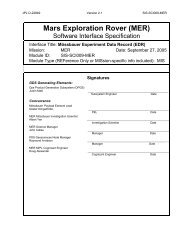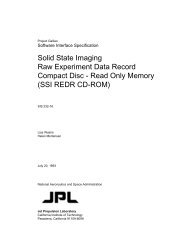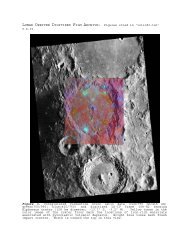SSI Raw Experiment Data Record (REDR) for Phase 2 - USGS PDS ...
SSI Raw Experiment Data Record (REDR) for Phase 2 - USGS PDS ...
SSI Raw Experiment Data Record (REDR) for Phase 2 - USGS PDS ...
You also want an ePaper? Increase the reach of your titles
YUMPU automatically turns print PDFs into web optimized ePapers that Google loves.
Solid State Imaging <strong>Raw</strong> <strong>Experiment</strong> <strong>Data</strong> <strong>Record</strong> Software Interface Specification<br />
E–1<br />
Appendix E<br />
BAD-DATA VALUE HEADER<br />
This section defines the <strong>for</strong>mat and contents of the binary labels used to store<br />
<strong>SSI</strong> bad-data values.<br />
There are two parts to the binary label: the binary header, and the binary<br />
prefix. The binary header precedes the image data (as do the ASCII labels)<br />
and contains in<strong>for</strong>mation which pertain to the entire image. The binary prefix<br />
precedes each image line and contains in<strong>for</strong>mation specific to each line. Binary<br />
labels are created by adding the U_NLB and U_NBB keywords to the<br />
XVOPEN call. Binary labels are accessed from a file already containing them<br />
by adding the CONDITION, BINARY keywords to the XVOPEN call. Note<br />
that since VICAR programs do not normally include these keywords in their<br />
XVOPEN calls, binary labels are usually ignored and disappear when new<br />
versions of an image are created. Binary labels were originally designed to<br />
support the generation of Voyager EDRs. The binary labels are written in VAX<br />
compatible (least significant byte first) <strong>for</strong>mat.<br />
The binary header consists of an arbitrary number of records. The first record<br />
contains ancillary telemetry in<strong>for</strong>mation. The remaining binary header records<br />
contain bad-data in<strong>for</strong>mation,stored as a sequence of "objects" in 16-bit integer<br />
<strong>for</strong>mat <strong>for</strong> EDRs and 8-bit integers <strong>for</strong> <strong>REDR</strong>s. The following types of objects<br />
have been defined:<br />
Object Type Code Format<br />
Single Pixels 1 Line, sample<br />
Line segments 2 line, starting-sample,<br />
number-of-samples<br />
Column segments 3 sample, starting-line,<br />
number-of-lines<br />
These objects are used to encode the following bad-data types:<br />
Bad <strong>Data</strong> Type <strong>Record</strong> ID Created By<br />
<strong>Data</strong> dropout 3 GALSOS or BADLABELS<br />
Saturated pixels 4 GALSOS or BADLABELS<br />
Low-full-well pixels 5 GALSOS or GLL BLEMCOR<br />
Single-pixel spikes 6 ADESPIKE<br />
Reed-Solomon overflow 7 GALSOS or BADLABELS





